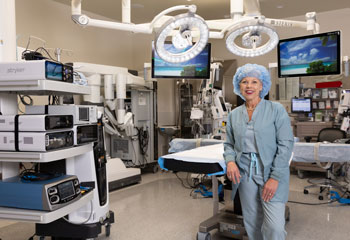
Benign Skull Base Tumors
Even a benign tumor under your skull can cause serious problems. Our neurologists are specially trained to diagnose and treat your skull base tumor.
Despite the anatomical complexity, we can spot and remove these hard-to-detect tumors, restoring your quality of life.
Skull base tumor symptoms
Skull base tumors are either benign or malignant and behave differently from each other, growing at different speeds. Your symptoms will vary based on whether the tumor is slow growing or not and its location.
Typical symptoms can include:
- a mass in the neck that you can feel
- balance issues
- difficulty swallowing
- dizziness
- fast or irregular heartbeat
- headaches
- hearing loss
- high blood pressure
- memory problems
- nausea
- optic nerve damage
- paleness and shakiness
- pulsing
- sweating
- tinnitus
- vocal cord paralysis
- vomiting (particularly in the morning)
- weakness in the limbs
- whooshing sound in the ear
When to seek care for a skull base tumor
If you suddenly have headaches or vision and hearing problems you never had before, seek care immediately. Go to your primary care doctor, the emergency room or make an appointment with our UCI Health Neurosurgery Program specialists.
A benign or malignant skull base tumor needs specialized care
It’s frightening to get a tumor diagnosis. To get the proper care, you need the advanced imaging and state-of-the-art treatments we offer at UCI Health.
Call now to speak with a specialist.

Find a neurology clinical trial
Talk to your doctor to see if a neurology clinical trial is right for you.
Featured Blog Posts

Rethinking surgery for a next-generation hospital

Parkinson’s disease: Knowledge is power

A 'dream come true' realized in Irvine
Dr. Michael J. Stamos once envisioned opening a small cancer center on the UC Irvine campus. What has emerged, he says, is so much more.
Our approach to diagnosing a skull base tumor
The delicate region beneath your brain allows you to see, hear, breathe, smell and taste. Due to the area's complexity, our neurologists require advanced training to accurately diagnose skull base tumors.
Our clinicians expertly identify your tumor type, location and the best treatment to preserve surrounding tissues. Because we are a university medical center, our specialists have access to the latest, most advanced diagnostic tools.
Throughout the diagnostic process, we consider the larger picture of your physical, mental and emotional health. During our consultation, we’ll show you your imaging scans, and make sure you understand your condition and treatment options.
Skull base tumor treatment at UCI Health
It’s difficult for doctors to see and reach the base of the skull. In the past, treating these disorders often involved surgery to open the skull. Fortunately, in recent years, ENT surgeons and neurosurgeons have developed advanced techniques.
We can reach these areas without disrupting vital tissues or open surgery.
Minimally invasive surgery
Our doctors use a minimally invasive endoscopic procedure, inserting instruments through your nose or mouth. We don’t make incisions, preventing facial scarring. This is the least invasive method, and you’ll likely recover quickly and with fewer side effects.
Sometimes, we may need to make a small incision above the eyebrow to remove tumors. In another minimally invasive procedure, your surgeon drills a tiny hole through the skull. They insert a small tube into the brain to take out the tumor.
With techniques like these, you avoid the longer recovery time of open surgery. There are also fewer risks and complications.
Stereotactic radiosurgery (SRS)
Stereotactic radiosurgery isn’t true surgery, it’s a form of radiation therapy. Our experts deliver tiny beams of radiation aimed precisely at the tumor. The highly focused beams deliver a maximum dose of radiation.
One major benefit of SRS is its precision. It minimizes harm to your healthy, surrounding tissues.
Ultrasonic bone removal
Instead of using a high-speed drill around delicate, critical brain structures, this device works to gently remove bone. This too minimizes damage to the surrounding tissue.
How to work with us
A malignant or even a benign tumor can cause new and difficult symptoms. If you’re dizzy, have headaches or vision and hearing problems, go to the doctor or the emergency room. Your doctor will conduct tests and if they don’t have access to the sophisticated imaging tests you need, you’ll get a referral.
You can always reach out and make an appointment with us directly.
The UCI Health Neurology and Neurosurgery program works hand-in-hand with the Headache program, the Neuroscience ICU, the head and neck surgery team, and ENT specialists.
Why choose UCI Health for skull base tumors?
Our UCI Health skull base team is thoroughly versed in the latest methods to diagnose and treat skull base diseases
Neurology and neurosurgery are already two of the most complex areas in medicine. Skull base tumor knowledge and experience is a further subspecialty within neurology. Our doctors have fellowship training and a deep understanding about how to navigate through this complicated region.
Our robust academic infrastructure gives us easy access to the sophisticated multidisciplinary teams needed to treat skull base tumors
When we diagnose and treat skull base tumors, we rely on multiple teams to get the full picture. We work regularly with our colleagues from neurosurgery, ear, nose and throat, head and neck surgery and many others. This ensures the accuracy needed to get you up and feeling better.
Our tumor board meets every week
Our clinicians find consensus about how to treat a difficult tumor or high-risk patient. Once you’re working with us and preparing for treatment, we’ll make sure to gather second opinions from each other. Our colleagues lend each other their expertise to make sure your surgery or therapy is exactly right for you.
Upcoming Events
Traumatic Brain Injury Survivors Support Group
Young Adult Cancer Support Group
The Young Adult Cancer Support Group provides help and support for individuals with cancer between the ages of 18 and 35 receiving active cancer treatment.




